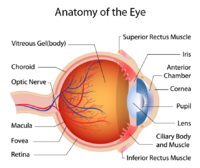Difference between revisions of "Retinal vasculature"
(→Introduction) |
|||
| Line 2: | Line 2: | ||
Supervised by '''Daniel Krefl'''</small><br> | Supervised by '''Daniel Krefl'''</small><br> | ||
== '''Introduction''' == | == '''Introduction''' == | ||
| + | [[File:retina.png|thumb|left|200px|<small>'''Fig. 1:'''Retinal Vasculature (arteries in red and veins in blue)</small>]] | ||
| + | |||
<small>The Retinal vasculature refers to the blood vessels that supply the retina, which is the thin layer of tissue located at the back of the eye.<br> | <small>The Retinal vasculature refers to the blood vessels that supply the retina, which is the thin layer of tissue located at the back of the eye.<br> | ||
It is responsible for detecting light and sending visual information to the brain. | It is responsible for detecting light and sending visual information to the brain. | ||
The retinal vasculature includes both arteries and veins, which branch out from the optic nerve and supply oxygen and nutrients to the retina. | The retinal vasculature includes both arteries and veins, which branch out from the optic nerve and supply oxygen and nutrients to the retina. | ||
</small> | </small> | ||
| − | |||
| − | |||
| − | |||
Revision as of 11:40, 27 May 2023
Project presented by Leïla Ouhamma & Audran Feuvrier
Supervised by Daniel Krefl
Introduction
The Retinal vasculature refers to the blood vessels that supply the retina, which is the thin layer of tissue located at the back of the eye.
It is responsible for detecting light and sending visual information to the brain.
The retinal vasculature includes both arteries and veins, which branch out from the optic nerve and supply oxygen and nutrients to the retina.
